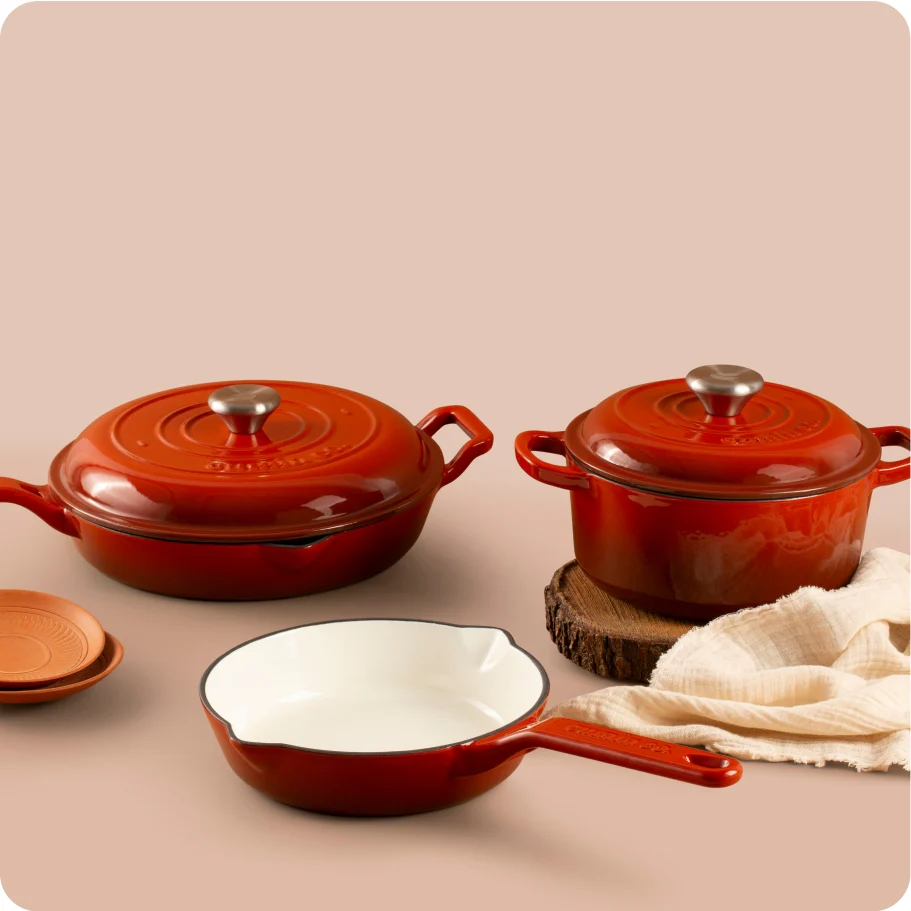Why Your Food Tastes Better in Cast Iron – The Science Behind Flavor Enhancement

Have you ever noticed how food cooked in cast iron cookware tastes richer and more flavorful? Whether it’s a crispy dosa, a sizzling steak, or a slow-cooked curry, cast iron cookware enhances flavors in ways that other cookware can’t. But why does this happen?
This guide explores the science behind cast iron’s superior flavor retention, its unique properties, and how to make the most of it in your kitchen. Whether you're using enameled cast iron cookware, a cast iron tawa, or cast iron pots and pans, you'll learn why this cookware is a kitchen essential.
Why Cast Iron Enhances Flavor
-
Superior Heat Retention
Cast iron cookware absorbs and distributes heat evenly, ensuring all ingredients cook uniformly. Unlike non-stick or stainless steel, cast iron retains heat for a longer period, which enhances caramelization and browning, crucial for developing deep, rich flavors. Whether you are searing meats or sautéing vegetables, the heat retention of cast iron cookware helps enhance the overall taste of the dish. -
Natural Non-Stick Surface Improves Texture
One of the key benefits of using enameled cast iron cookware is its smooth, natural non-stick surface, which prevents food from sticking and drying out. In the case of traditional cast iron cookware (when well-seasoned), the layer of natural oils that build up over time helps improve texture and flavor. This is why foods like roti, paratha, or even pancakes made in cast iron tawa are crispy yet soft inside, with a golden-brown finish that you won’t get with other cookware. -
Micro-Textured Surface Locks in Flavor
Unlike synthetic-coated pans, cast iron has tiny pores that hold onto seasoning and spices, making it ideal for bold, flavorful dishes. This unique feature allows the pan to absorb and release the seasoning with every use, which in turn enhances the taste of your food. Whether you're cooking Indian dishes like dosa or slow-cooked curries, the cast iron tawa helps infuse your food with deep, rich flavors.
The Science of Cast Iron Cooking
The Maillard Reaction – Why Your Food Tastes Better
When food is cooked at high heat, it undergoes a chemical reaction between amino acids and sugars, known as the Maillard Reaction, which creates a deep, rich flavor. The surface of cast iron cookware retains heat evenly, allowing the Maillard Reaction to occur properly, giving food a golden-brown, flavorful crust that is simply unmatched by other types of cookware.
Retention of Essential Nutrients
Cooking in cast iron cookware can increase the iron levels in food, making it a beneficial choice for those with iron deficiencies. Unlike non-stick or aluminum cookware, cast iron pots and pans do not strip away essential nutrients, making it a healthier option for cooking.
Oil Absorption and Seasoning Benefits
Over time, cast iron cookware develops a unique layer of seasoning that enhances the flavor of each dish. The more you cook with it, the more flavorful your food becomes. Whether you’re using enameled cast iron cookware for easy non-stick performance or a traditional cast iron tawa for added seasoning, the cooking surface improves with every use.
Best Foods to Cook in Cast Iron for Maximum Flavor
-
Indian Dishes
-
Dosa, Rotis, and Parathas – Cast iron tawa creates crispy, golden results without the worry of sticking. The heat retention ensures perfect browning.
-
Curries & Slow-Cooked Dishes – Cast iron cookware retains heat for long periods, allowing flavors to develop deeply.
-
Meats & Vegetables
-
Steaks & Kebabs – The ability of cast iron cookware to sear at high heat locks in the natural juices of meats, making them tender and flavorful.
-
Roasted Vegetables – Cast iron ensures even browning without burning, enhancing the taste of the veggies.
-
Baked Goods
-
Sourdough Bread – Cast iron cookware gives a crispy crust while maintaining a soft, tender interior.
-
Cornbread & Pizzas – Perfectly golden and well-baked, thanks to the heat retention properties of cast iron pots and pans.
How to Get the Best Flavor Out of Your Cast Iron Cookware
Step 1: Preheat the Pan Properly
Always preheat cast iron cookware for at least 3-5 minutes before adding food. A well-preheated pan ensures even cooking and prevents food from sticking.
Step 2: Use the Right Amount of Oil
Enameled cast iron cookware requires minimal oil for cooking. If using traditional cast iron cookware, apply a thin layer of oil to maintain the seasoning and prevent rust.
Step 3: Avoid Overcrowding the Pan
Cooking in batches ensures proper caramelization and prevents steaming. When cooking meats, leave enough space for a proper sear.
Step 4: Let Food Rest Before Serving
Allowing food to rest for a few minutes helps the flavors settle and deepen. This is especially important for meats and roasted vegetables.
Cleaning and Maintaining Cast Iron for Long-Lasting Flavor
For Enamel-Coated Cast Iron:
-
Use mild soap and a soft sponge to clean.
-
Avoid harsh abrasives that can dull the finish.
-
Dry thoroughly to prevent moisture buildup.
For Traditional Cast Iron:
-
Clean with warm water and avoid soap.
-
Dry immediately and apply a light coat of oil to maintain seasoning.
-
Store in a dry place to prevent rust.
Final Thoughts: Why Cast Iron is the Key to Delicious Cooking
Cooking with cast iron cookware isn’t just about durability—it’s about unlocking the full potential of flavors in your food. Whether you’re using enameled cast iron cookware for effortless non-stick performance or a traditional cast iron tawa for deep-seasoned flavor, this cookware enhances every meal. It allows you to explore new textures, aromas, and flavors that you simply can't achieve with other cookware.
Try cast iron cookware yourself and taste the difference with every bite!
 Pots and Pans
Pots and Pans
 Tawa
Tawa Kitchen Accessories
Kitchen Accessories












